Notes and Tips on Collecting Jewelry
[retrieved from https://www.cajunc.com/jewelry]Copper and Costume Jewelry
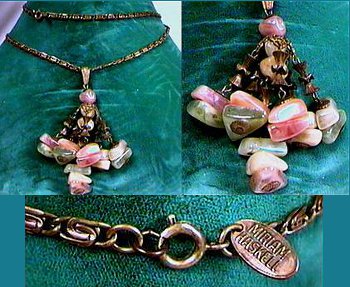
When you think of jewelry, you probably consider gold and silver, but vintage and antique costume jewelry can be investment quality as well. Some of the designer jewelry from the 1920s – Hattie Carnegie, Alice Caviness, Miriam Haskell and Elsa Schiaparelli for example – are valuable and collectible for artistic and historical reasons.
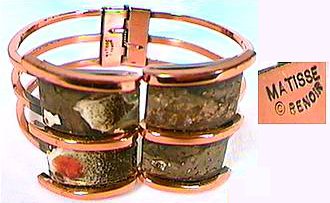
Copper jewelry from the 1950s in mid-century modern designs is another niche for collectors. Bakelite and early plastic jewelry is valuable. Select the style that has the most appeal for you or that you think best reflects an era. Or choose a geographical region.
We live in Texas, so we collect Texas contemporary jewelry and vintage Mexican jewelry. Ginnie Johansen is a Texas designer; Marcie makes pewter jewelry in this area; Jeep Collins and James Avery work in precious metals.
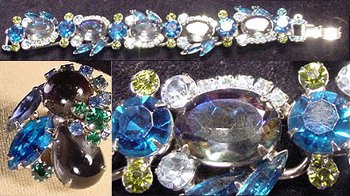
Juliana Jewelry is another collectible costume jewelry from the 1960s, marked with a hang tag only. Numerous stones of different sizes and lots of glitz identify these pieces from DeLizza and Elster of New York City. The hang tags are often marked "Gloria" or "Tara" but if you're interested in collecting these beautiful baubles, learn the characteristics so you don't rely on a hang tag that may be copied.
For more information on Juliana Jewelry, see Morning Glory Antiques & Jewelry's Juliana Jewelry Information. There are plenty of photos of Juliana jewelry from their collection (along with Cheryl Kilmer's collection, from Past Perfection Vintage Costume Jewelry). Notably – photos of the "Gloria" and "Tara" tags, if you're curious.
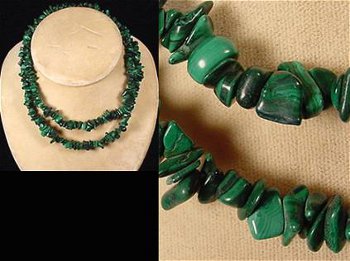
If you live in southwestern U.S., you may choose Native American jewelry or you may choose to collect one artisan's work or maybe all natural products – stones, bone, wood or even animal teeth. You can find a niche and start a collection for wear or display – soon you'll have an investment that you can resell at a profit.
Gold
You may pay less for costume jewelry and it may go up in value faster than silver and gold. Then, again, silver and gold are more "solid" and acceptable investments, although you're not as likely to find it cheap.
If you choose to collect gold or silver jewelry, there's a little learning curve before you're comfortable with paying much for a necklace, bracelet, ring or earrings. Most of the precious metals are marked, but you'll need to know the marks and how to spot the fakes. Anyone can use a punch tool and mark a piece of jewelry .925 or 14k, but you can learn the difference between the real thing and fake stamps.
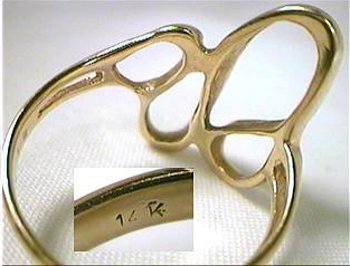
You'll need a jeweler's loupe with 10x magnification. When you look at the indented mark, examine the sharp edges where the punch tool pierced the metal. If you can see a thin layer at the top, you're not looking at a pure metal. That's the look of silverplate or gold plate. Gold or silver jewelry will be the same all the way through, so checking the edges can often give you an idea whether your jewelry is plated or solid.
Gold testing with an electronic tester will tell you the karat gold. Gold content is often lower than the stamped number, i.e. 14k stamped is often 13k gold. Gold that is exactly on the mark is often stamped 14kp. That's for 14k plumb, not plate. Plumb means "exactly" so it's close to 58.555 percent gold.
If you see .750 on a piece of jewelry, you may have gold jewelry, although it looks like silver. White gold from Europe may be 18k gold and marked .750. Jewelry marked .585 is European gold in 14k. Don't mistake these for silver marks.
Silver

Silver is .800 for coin silver or 80 percent silver and 20 percent alloy. Sterling silver is .925 or 92 1/2 percent silver to be sterling in the U.S., but .900 and .830 are also silver marks we see from foreign countries. Old Mexican silver is sometimes .950.
You can test silver with nitric acid, but it isn't foolproof and damages the silver finish slightly. You can learn to identify silver by the look, the feel, and by looking closely with the loupe.
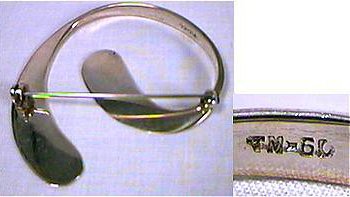
Check an edge or a corner with the loupe to look for wear. You may see that the surface metal is worn and another metal shows through. That's not likely sterling silver, but it could be sterling silver with rhodium plating or vermeil (pronounced vermay) that is gold wash over sterling silver. It could also be a cheap metal with silverplate coating.
Learn the difference in appearance and you'll be able to add to your collection. Silver and gold look more like liquid poured in a form than most of the metals that are sharp cut edges smoothed for jewelry.
Lead Content
If your're tempted to wear your jewelry constantly, you might check for lead content. Many crystals have high lead content, but some of the metals do as well. Be even more cautious if you allow your children or grandchildren to wear old costume jewelry.
Vintage and Newer Sterling Silver and Other Fine Jewelry for Sale
We have other articles on identifying jewelry if you're interested.
For the items below: click on the photo if you want to purchase from our iOffer store, or contact us if you want a larger photo.
Email us if you have a special piece of jewelry you are looking for. We sell costume jewelry, too.